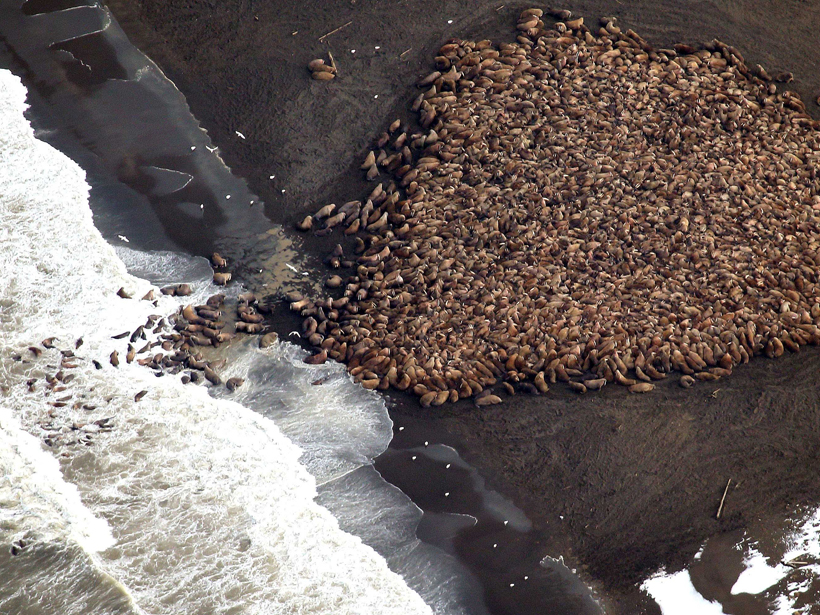Warming conditions in the Arctic continue to transform the region, with changes in the sea ice alone having “profound” effects on the marine ecosystem and sea surface temperatures, according to the 2015 Arctic Report Card issued at a briefing on 15 December at the American Geophysical Union’s (AGU) Fall Meeting in San Francisco, Calif.
“There are many signals indicating that environmental system components throughout the Arctic continue to be influenced by long-term upward trends in air temperature, modulated by natural variability in regional and seasonal anomalies,” according to the peer-reviewed report sponsored by the National Oceanic and Atmospheric Administration (NOAA). This tenth annual edition of the report comprised the efforts of 72 researchers in 11 countries.
“Changes in the region affect climate globally and security internationally,” Spinrad said.
Among the report’s findings are that in 2015 the maximum Arctic Ocean sea ice extent occurred 15 days earlier than average and was 7% less than the average for 1981–2010. The annual average air temperature over land areas was 1.3°C above average between October 2014 and September 2015 and was the highest value in the observational record beginning in 1900. Air temperatures in all seasons between October 2014 and September 2015 exceeded 3°C above average over broad areas of the Arctic. Melting occurred over more than 50% of the Greenland ice sheet for the first time since an “exceptional” melting in 2012.
The report also documents changes to snow cover; Arctic Ocean temperature and productivity; river water discharge; vegetation; and fish and wildlife, including walruses and other “ice-associated” marine mammals.

“Warming is happening more than twice as fast in the Artic than anywhere else in the world,” NOAA chief scientist Rick Spinrad said at the briefing. “We know this is due to climate change, and its impacts are creating major challenges for Arctic communities who depend on the region for sustenance and cultural identity. We also know what happens in the Arctic doesn’t stay in the Arctic. Changes in the region affect climate globally and security internationally.”
Spinrad told Eos that the report card “represents excellent environmental intelligence” and that NOAA, which invests about $115 million on Arctic research and operations, uses the report extensively in its planning. “When we see these kinds of indicators, it gives us some sense of where the observations can be enhanced and where we ought to prioritize,” he said. Spinrad said NOAA’s priorities in the Arctic include improving weather and sea ice forecasting; increasing understanding of climate impacts on biological resources, human health, and natural habitats; and developing navigational services that transportation, energy, and other industries need.
Data Document Arctic Impact
“Frankly, the picture doesn’t look great, given the predictions for the future of the sea ice cover and for the continuing loss of ice from the Greenland ice sheet and the consequences that has for sea level rise,” Martin Jeffries, the principal editor of the report card, told Eos. Jeffries is the Arctic science adviser and program officer for the Arctic and Global Prediction program with the U.S. Office of Naval Research in Arlington, Va.

Jeffries said that the change in sea ice is a major concern because sea ice cover is so important to the climate system and as a habitat. “If you lose so much sea ice in the summertime, then you warm up the ocean surface water and that warmth is then given up to the atmosphere in the fall when the ice starts to advance again,” he said.
Report card editor Jacqueline Richter-Menge added that the loss of sea ice is driving commercial decisions and posing homeland security concerns. Richter-Menge is a research civil engineer at the U.S. Army Corps of Engineers’ Cold Regions Research and Engineering Laboratory in Hanover, N.H. She added that in addition to the sea ice changes, what impressed her the most in the report card are “the numerous signals that are telling the story of the impact of persistent change” in response to warming.
“You cannot produce a model that actually reproduces this change unless you include an anthropogenic or humankind element to it,” Richter-Menge said.
In their interview with Eos, both scientists said that the changes in the Arctic are dramatic but that whether the changes in the region are good or bad news is a matter of somebody’s perspective. They also emphasized that the data provide a strong understanding of the changes and show the value of the investments made by federal agencies and others to install observational networks.
“At least we have the robust observations to tell us these changes are occurring,” noted Richter-Menge, saying that is perhaps a silver lining amid the changes. “At least,” she said, “that’s cause to be positive and glad, because what could be worse than being totally in the dark about what’s going on?” She added that one thing she finds “extremely sobering” about Arctic changes over the past several decades “is realizing the role that humankind has played in causing those changes to happen, the fact that you cannot produce a model that actually reproduces this change unless you include an anthropogenic or humankind element to it.”
Jeffries said that if somebody had told him 30 years ago that the Arctic would be so different today, “I would have thought they were crazy. I would never have imagined that things could change so quickly.”
—Randy Showstack, Staff Writer
Citation: Showstack, R. (2015), Arctic report card highlights profound regional changes, Eos, 96, doi:10.1029/2015EO041933. Published on 16 December 2015.
Text © 2015. The authors. CC BY-NC 3.0
Except where otherwise noted, images are subject to copyright. Any reuse without express permission from the copyright owner is prohibited.

